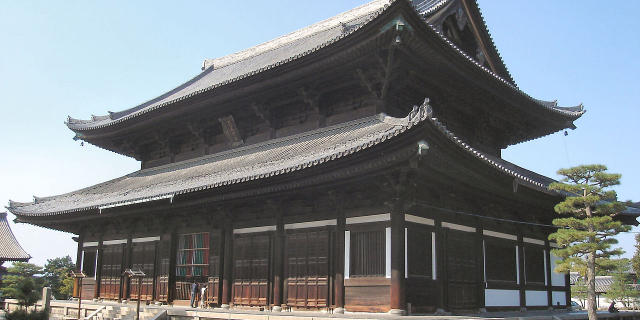慈照寺
( Ginkaku-ji )Ginkaku-ji (銀閣寺, lit. "Temple of the Silver Pavilion"), officially named Jishō-ji (慈照寺, lit. "Temple of Shining Mercy"), is a Zen temple in the Sakyo ward of Kyoto, Japan. It is one of the constructions that represent the Higashiyama Culture of the Muromachi period.
 View of Ginkaku-ji and Tōgudō
View of Ginkaku-ji and TōgudōAshikaga Yoshimasa initiated plans for creating a retirement villa and gardens as early as 1460, and it functioned as a pleasure villa for the shoguns to rest from their administrative duties. After his death, Yoshimasa arranged for this property to become a Zen temple under the name Jishō-ji.[1] The temple is today associated with the Shokoku-ji branch of Rinzai Zen.
The two-storied Kannon-den (観音殿, Kannon hall), is the main temple structure. Its construction began February 21, 1482 (Bummei 14, fourth day of the second month).[2] For the structure's design, Yoshimasa sought to emulate the golden Kinkaku-ji, which had been commissioned by his grandfather Ashikaga Yoshimitsu. It is popularly known as Ginkaku, the "Silver Pavilion," because of the initial plans to cover its exterior in silver foil, but this familiar nickname dates back only as far as the Edo period (1600–1868).[3]
During the Ōnin War, construction was halted. Despite Yoshimasa's intention to cover the structure with a distinctive silver foil overlay, this work was delayed so long that the plans were never realized before Yoshimasa's death. The present appearance of the structure is understood to be the same as when Yoshimasa himself last saw it. This "unfinished" appearance illustrates one of the aspects of "wabi-sabi" quality.[4]
Like Kinkaku-ji, Ginkaku-ji was originally built to serve as a place of rest and solitude for the Shōgun. During his reign as Shōgun, Ashikaga Yoshimasa inspired a new outpouring of traditional culture, which came to be known as Higashiyama Bunka (the Culture of the Eastern Mountain). Having retired to the villa, it is said Yoshimasa sat in the pavilion, contemplating the calm and beauty of the gardens as the Ōnin War worsened and Kyoto was burned to the ground.
In 1485, Yoshimasa became a Zen Buddhist monk. After his death on January 27, 1490 (Entoku 2, seventh day of the first month),[5] the villa and gardens became a Buddhist temple complex, renamed Jishō-ji after Yoshimasa's Buddhist name.
After extensive restoration, which started in February 2008, Ginkaku-ji is again in full glory to visit. The garden and temple complex are open to the public. There is still no silver foil used. After much discussion, it was decided not to refinish the lacquer to the original state[citation needed] . The lacquer finish was the source of the original silver appearance of the temple, with the reflection of the silver water of the pond on the lacquer finish.



































Add new comment